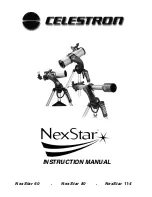
Congratulations on your purchase of the Celestron NexStar! Whether you have the NexStar ST for hands-on star
hopping to the moon and planets or the NexStar GT with its database of 4,000 nighttime objects, the NexStar series of
telescopes are designed to give you a lifetime of observing pleasure while growing as your interest in astronomy grows.
No matter at what level you are starting out, the NexStar will unfold for you and your friends all the wonders of the
Universe.
This manual is broken up into three major sections. The assembly section details all the steps necessary to assemble any
of the NexStar series of telescopes. The assembly section covers the procedures that are common to the NexStar 60, 80
and 114 telescopes. No matter which NexStar you own, start with this section to properly assemble your telescope.
The next section of this manual gives detailed information about the specific NexStar models. There is a separate section
for the operation of the NexStar ST, NexStar HC or NexStar GT. Each section describes the use of the manual motion
controls, motor control and computerized hand control. Read the section that pertains to your model of NexStar.
The final section of the manual covers topics including telescope and astronomy basics, as well as celestial observing
techniques. This section will also tell you the proper way to care for your telescope and the many optional accessories
that can help you get the most out of your telescope.
The NexStar’s deluxe features combine with Celestron’s legendary optics to give amateur astronomers one of the most
sophisticated and easy to use telescopes available on the market today.
Take time to read through this manual before embarking on your journey through the Universe. It may take a few
observing sessions to become familiar with your NexStar, so you should keep this manual handy until you have fully
mastered your telescope’s operation.
Your NexStar telescope is designed to give you years of fun and rewarding observations. However, there are a few
things to consider before using your telescope that will ensure your safety and protect your equipment.
Warning
Never look directly at the sun with the naked eye or with a telescope (unless you have the proper solar filter).
Permanent and irreversible eye damage may result.
Never use your telescope to project an image of the sun onto any surface. Internal heat build-up can damage the
telescope and any accessories attached to it.
Never use an eyepiece solar filter or a Herschel wedge. Internal heat build-up inside the telescope can cause these
devices to crack or break, allowing unfiltered sunlight to pass through to the eye.
Never leave the telescope unsupervised, either when children are present or adults who may not be familiar with the
correct operating procedures of your telescope
.





































